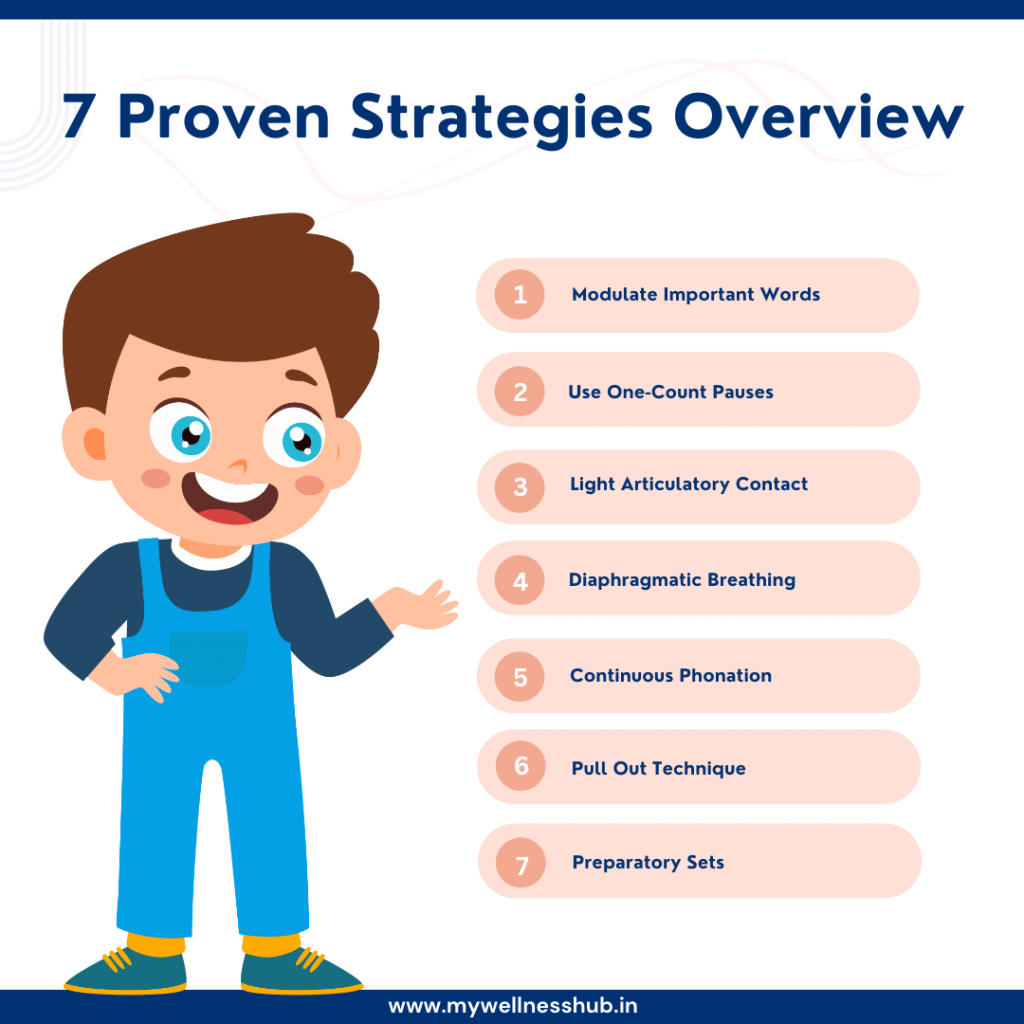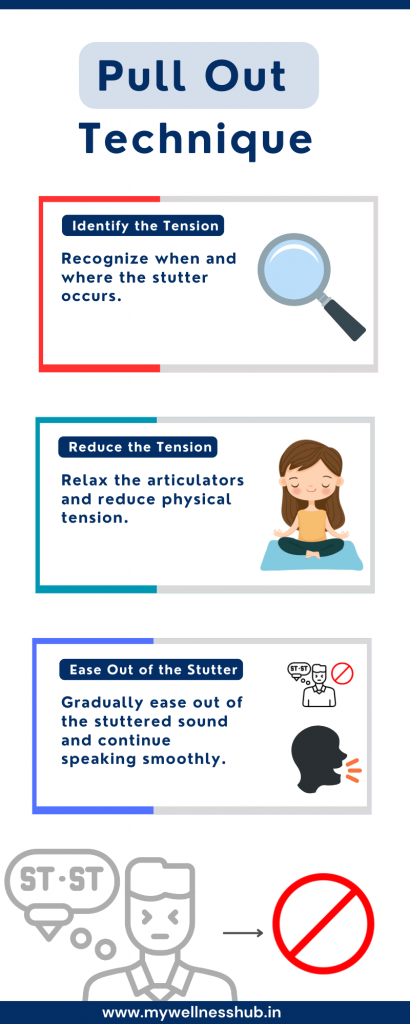7 Proven Ways to Improve Speech Fluency & Stop Stuttering
Last Updated: August 24, 2024
Stuttering can be a challenging obstacle in your journey to clear and confident communication. If you or someone you know struggles with stuttering, you’re not alone. Many famous personalities have faced the same hurdle and successfully overcome it. Take, for instance, the legendary actress Marilyn Monroe, who used a unique breathing technique to manage her stutter. Similarly, singer Ed Sheeran found solace in singing, which helped him articulate words smoothly. Even Joe Biden, the President of the United States, turned to poetry to conquer his speech disfluency.
These individuals didn’t let their stutter define them. Instead, they embraced techniques that allowed them to speak fluently and confidently. This article aims to share seven proven strategies to enhance fluency and reduce stuttering, providing practical advice that you can apply in your daily life.

Modulate Important Words
One effective strategy to enhance fluency and reduce stuttering is learning how to modulate important words in your speech. Modulating your speech means varying the tone, pitch, and emphasis you place on certain words. This technique can make your speech more engaging and help you maintain control, reducing the likelihood of stuttering.
When you modulate your speech, you focus on emphasizing key words that are crucial to your message. By doing so, you draw attention to the most important parts of your speech, making it clearer and more compelling for your listeners. This also helps in distributing the effort required to speak, which can reduce tension and the chance of a stutter.
Read more: Stuttering in the Workplace: What Employers Need to Know
Practical Example
Let’s say you’re giving a presentation and you want to emphasize the importance of communication. Instead of saying, “Communication is important,” you can modulate the key word: “Communication is important.”
Here’s a step-by-step way to practice this technique:
- Identify Key Words: Before you start speaking, identify the key words in your sentences that carry the most weight.
- Practice Modulation: Practice saying these words with different tones and pitches. For example, try saying “important” with a higher pitch or a louder volume.
- Integrate into Speech: Start incorporating this modulation naturally into your speech. When you feel a stutter coming on, shift your focus to emphasizing the next key word with a modulated tone.
Example Practice Sentence:
- Normal: “The project deadline is approaching.”
- Modulated: “The project deadline is approaching.”
By regularly practicing this technique, you can make your speech more dynamic and less prone to stuttering.
To further explore how modulation can help improve speech, check out our guide on preparing your child for their upcoming online speech therapy appointment.
Use One-Count Pauses
Incorporating pauses into your speech is a powerful technique to enhance fluency and reduce stuttering. One-count pauses, in particular, can help you manage the rhythm of your speech and provide you with the time needed to articulate words clearly and confidently.
Importance of Incorporating Pauses in Speech
Pauses are essential for several reasons. Firstly, they allow you to gather your thoughts and plan your next words, reducing the likelihood of stuttering. Pauses also help to break down your speech into manageable chunks, making it easier to control the flow of words. Additionally, pauses give your listeners a moment to absorb the information you are sharing, making your communication more effective and engaging.
When you incorporate pauses, especially one-count pauses, you create a natural rhythm in your speech that can make it smoother and more fluent. This technique helps to reduce the pressure on yourself to speak continuously, which can often lead to stuttering.
Tips on Practicing One-Count Pauses
- Identify Natural Breaks: Look for natural breaks in your sentences where you can insert a pause. These can be between phrases, after punctuation marks, or at the end of thoughts.
- Practice Timing: Use a mental count of “one” to practice your pauses. For example, say a sentence like, “I am going to the store,” and insert a pause after each word: “I (pause) am (pause) going (pause) to (pause) the (pause) store.”
- Use Breathing: Coordinate your pauses with your breathing. Take a breath in during the pause, which can help you relax and prepare for the next part of your speech.
- Start Slow: Begin by incorporating longer pauses and gradually reduce them as you become more comfortable. You might start with a two-count pause and then move to a one-count pause as you gain confidence.
- Record and Review: Record yourself speaking with one-count pauses and review the recording to identify areas for improvement. This can help you become more aware of your speech patterns and make necessary adjustments.
Example Practice Sentence:
- Without Pauses: “I am going to the store to buy some groceries.”
- With One-Count Pauses: “I (pause) am (pause) going (pause) to the (pause) store (pause) to buy (pause) some groceries.”
By practicing one-count pauses, you can significantly improve your speech fluency and reduce stuttering.
Light Articulatory Contact
Light articulatory contact is a powerful technique to help reduce stuttering by minimizing the tension in your speech muscles. This method involves using gentle contact with your articulators—your lips, teeth, and tongue—when forming sounds. By doing so, you can prevent the hard stops and abrupt closures that often lead to stuttering.
Explanation of Gentle Contact with Articulators
When we speak, we use different parts of our mouth to form sounds. For instance, the /p/ sound requires the lips to come together and release a burst of air, while the /t/ sound involves the tongue touching the roof of the mouth. If there’s too much tension in these movements, it can cause a disruption in the flow of speech, leading to stuttering.
Light articulatory contact means making these movements with as little force as possible. Think of it as lightly touching a piece of paper with a pen instead of pressing down hard. This gentler approach helps to reduce the tension and allows for smoother transitions between sounds.
Practice Exercise with Example Words
Here’s how you can practice light articulatory contact:
- Choose a Sound to Practice: Start with a plosive sound like /p/, /t/, or /k/, which are common trouble spots for stuttering.
- Produce the Sound Gently: Focus on making the sound with the lightest possible contact. For example, when practicing /p/, bring your lips together very gently and release the air softly.
- Repeat with Different Words: Use the target sound in various words to get comfortable with the technique. Start with single words and then move to short sentences.
Example Words and Sentences:
- /p/: “paper,” “puppy,” “pencil”
- Sentence: “The puppy played with a paper ball.”
- /t/: “table,” “turtle,” “ticket”
- Sentence: “The turtle took the ticket to the table.”
- /k/: “kite,” “cat,” “cookie”
- Sentence: “The cat chased the kite while eating a cookie.”
- Monitor Your Tension: Pay attention to how your lips, tongue, and teeth are moving. Ensure they are making light contact without any unnecessary pressure.
- Practice Regularly: Consistency is key. Practice this technique daily to build muscle memory and make gentle contact a natural part of your speech.
Diaphragmatic Breathing
Proper breathing is crucial for speech fluency, and diaphragmatic breathing, also known as deep breathing, is a technique that can help reduce stuttering. By focusing on breathing from the diaphragm rather than the chest, you can maintain a steady airflow, relax your muscles, and create a smoother speech pattern.
Importance of Proper Breathing for Fluency
When you breathe shallowly from your chest, it can create tension in your neck and throat muscles, leading to a higher likelihood of stuttering. Diaphragmatic breathing, on the other hand, helps to:
- Reduce tension in the vocal cords and articulators.
- Provide a consistent airflow that supports continuous speech.
- Promote relaxation and reduce anxiety, which are often linked to stuttering.
By mastering this breathing technique, you can improve your overall speech fluency and feel more confident while speaking.
Exercise for Practicing Diaphragmatic Breathing
Here’s a simple exercise to help you practice diaphragmatic breathing:
- Find a Comfortable Position: Sit or lie down in a comfortable position with your shoulders relaxed. Place one hand on your chest and the other on your abdomen.
- Inhale Deeply: Breathe in slowly through your nose, allowing your abdomen to expand as you fill your lungs with air. Your chest should remain relatively still, and you should feel the hand on your abdomen rise.
- Exhale Slowly: Breathe out slowly through your mouth, letting your abdomen fall as you expel the air. Your chest should remain still, and you should feel the hand on your abdomen lower.
- Repeat the Process: Continue this deep breathing pattern for a few minutes, focusing on the rise and fall of your abdomen. Aim to make each breath slow and controlled.
Practice Tips:
- Consistency: Practice diaphragmatic breathing daily for at least 5-10 minutes. The more you practice, the more natural it will become.
- Incorporate Speech: Once you’re comfortable with the breathing technique, try speaking while maintaining diaphragmatic breathing. Start with simple phrases and gradually move to longer sentences.
- Stay Relaxed: Remember to stay relaxed throughout the exercise. If you feel tension building, take a moment to reset and refocus on your breathing.
Example Practice Sentence:
- Before speaking, take a deep diaphragmatic breath and say: “I am going to the store” while slowly exhaling.
Continuous Phonation
Continuous phonation is a valuable technique for maintaining vocal cord vibrations throughout speech, which helps reduce stuttering. By keeping the vocal cords vibrating, you can create a smoother and more continuous flow of speech, reducing the chances of blocks and breaks.
Explanation of Maintaining Vocal Cord Vibrations
When you speak, your vocal cords vibrate to produce sound. Continuous phonation involves maintaining these vibrations without stopping, even when transitioning between words and sounds. This constant vibration prevents the sudden stops and starts that can trigger stuttering.
The key to continuous phonation is to keep a gentle, steady flow of sound as you speak. This helps to ensure that the vocal cords remain engaged and active, making it easier to move smoothly from one sound to the next.
Practice Exercise
Here’s a practical exercise to help you master continuous phonation:
- Start with a Gentle Hum: Begin by humming a simple, continuous sound, like “mmmm.” Focus on keeping the hum steady and uninterrupted.
- Transition to Words: While maintaining the hum, start introducing simple words. For example, “mmmm-mom” or “mmmm-milk.” The goal is to keep the vocal cord vibrations going as you transition from the hum to the word.
- Practice Sentences: Once you’re comfortable with individual words, move on to short sentences. Begin with something simple, like “I am going to the store.” Focus on maintaining a continuous flow of sound throughout the sentence.
- Use Gentle Onsets: When starting a new word or sentence, use a gentle onset by beginning with a soft sound to keep the vocal cords vibrating. For example, start a sentence with a prolonged “ah” sound: “Ahhhh-I am going to the store.”
- Monitor Your Breathing: Ensure your breathing supports continuous phonation by practicing diaphragmatic breathing. Take deep breaths and exhale slowly as you speak, maintaining a steady flow of air.
Example Practice Sentence:
- Without Continuous Phonation: “I am going to the store.”
- With Continuous Phonation: “I (hum) am (hum) going (hum) to (hum) the (hum) store.”
Example Sentences for Practice
| Technique | Example Sentence |
|---|---|
| Modulate Important Words | “Communication is important.” |
| One-Count Pauses | “I (pause) am (pause) going (pause) to (pause) the (pause) store.” |
| Light Articulatory Contact | “The puppy played with a paper ball.” (gently articulating each sound, especially the plosives like /p/) |
| Diaphragmatic Breathing | “I am going to the store.” (take a deep diaphragmatic breath before starting the sentence and exhale slowly) |
| Continuous Phonation | “I (hum) am (hum) going (hum) to (hum) the (hum) store.” (maintaining continuous vocal cord vibrations throughout) |
| Pull Out Technique | “I go to ssss-chooool every day.” (identify tension on the “s” sound, reduce it, and ease into the rest of the word) |
| Preparatory Sets | “I want an aaaaa-pple.” (anticipate the “a” sound in “apple” and stretch it out to reduce tension) |
Pull Out Technique

The pull-out technique is a valuable strategy for managing stuttering during a speech moment. Instead of trying to avoid or stop a stutter, this technique involves modifying the stutter as it happens. By identifying the tension causing the stutter and gradually easing out of it, you can continue speaking more fluently.
Explanation of the Pull-Out Technique
When you stutter, it often happens because of tension in the muscles used for speech. The pull-out technique helps you recognize this tension and slowly release it, allowing you to finish the word or phrase smoothly. This technique involves three main steps:
- Identify the Tension: Notice where the tension is occurring during the stutter. It could be in your lips, tongue, or throat.
- Reduce the Tension: Focus on relaxing the tense muscle while you are still in the stutter.
- Ease Out of the Stutter: Gradually ease out of the stutter by continuing to speak the word slowly and smoothly.
Practical Example with a Challenging Word
Let’s take the word “school,” a common challenging word for many who stutter. Here’s how you can apply the pull-out technique:
- Identify the Tension: Suppose you stutter on the “s” sound in “school” and it comes out as “sssschool.” Recognize that the tension is in your tongue as you form the “s” sound.
- Reduce the Tension: While holding the “s” sound, focus on relaxing your tongue and reducing the pressure. You might do this by gently moving your tongue or taking a slight breath.
- Ease Out of the Stutter: Slowly and smoothly continue the word, transitioning from the “s” to the rest of the word: “sss-chooool.”
Practice Exercise:
- Choose a word you find challenging, like “school.”
- Practice saying the word slowly, paying attention to where you typically stutter.
- Apply the pull-out technique by identifying the tension, reducing it, and easing out of the stutter.
Example Practice Sentence:
- Without Pull-Out: “I go to sssssschool every day.”
- With Pull-Out: “I go to ssss-chooool every day.”
Navigating through the differences between in-person and online speech therapy can help you decide the best approach for applying techniques like the pull-out method.”
Preparatory Sets
Preparatory sets are an effective technique for managing stuttering, particularly for words that you anticipate might cause difficulty. This strategy involves anticipating problematic words and preparing to say them by stretching the initial sounds, which can help you start the word smoothly and reduce the chances of stuttering.
Anticipating and Preparing for Feared Words
One of the first steps in using preparatory sets is to identify and anticipate words or sounds that you commonly stutter on. These are often referred to as “feared words.” By recognizing these words in advance, you can prepare yourself to use the preparatory set technique, which involves adjusting how you begin these words.
Example: If you know you often stutter on the word “apple,” you can use a preparatory set to manage the initial “a” sound.
Tips for Stretching Initial Sounds
Stretching the initial sound of a word involves elongating the first sound in a controlled and relaxed manner. This technique helps to reduce tension and allows you to transition smoothly into the rest of the word.
Here are some tips for practicing and using preparatory sets:
- Identify the Target Word: Choose a word that you often stutter on and focus on the initial sound that is problematic.
- Start with a Gentle Onset: Begin the word with a gentle onset, using a slow and controlled approach to the initial sound.
- Elongate the Initial Sound: Stretch the initial sound slightly longer than usual. For example, if the word is “apple,” start with “aaaaa-pple.”
- Practice with Different Words: Practice this technique with a variety of words that have different initial sounds. This helps you become comfortable using preparatory sets in different contexts.
- Incorporate into Sentences: Once you are comfortable with individual words, practice using preparatory sets in sentences. This helps you integrate the technique into natural speech.
Example Practice Sentence:
- Without Preparatory Set: “I want an apple.”
- With Preparatory Set: “I want an aaaaa-pple.”
Techniques and Their Benefits
| Technique | Benefit |
|---|---|
| Modulate Important Words | Emphasizes key points, making speech more engaging and helping to maintain control over stuttering. |
| One-Count Pauses | Controls speech rhythm, allowing time to gather thoughts and reducing tension, leading to smoother speech. |
| Light Articulatory Contact | Gentle contact with articulators reduces muscle tension, leading to improved fluency and smoother speech. |
| Diaphragmatic Breathing | Supports steady airflow by using deep breathing from the diaphragm, which reduces anxiety and helps maintain a consistent speech flow. |
| Continuous Phonation | Maintains continuous vocal cord vibrations, which smoothes transitions between words and reduces stuttering. |
| Pull Out Technique | Helps manage stuttering during speech by identifying and reducing tension, allowing for a smoother continuation of speech. |
| Preparatory Sets | Anticipates and prepares for feared words by stretching initial sounds, reducing tension and improving speech fluency. |
Conclusion
Practicing and sticking with these seven strategies can greatly improve your speech fluency and reduce stuttering. It’s important to be patient and give yourself time to see results. Each technique requires consistent practice, and over time, you will notice positive changes in how you speak. Remember, it’s a gradual process, and every bit of progress is a step forward.
At Wellness Hub, we understand how challenging it can be to deal with stuttering. Our expert therapists are here to provide you with personalized advice and resources tailored to your needs. For more information on specific techniques or to explore comprehensive speech therapy programs, visit our Speech Therapy Services. Take the first step towards clearer and more confident speech today.
Frequently Asked Questions:
1. What are some effective strategies to reduce stuttering?
Effective strategies to reduce stuttering include modulating important words, using one-count pauses, practicing light articulatory contact, utilizing diaphragmatic breathing, maintaining continuous phonation, applying the pull-out technique, and using preparatory sets for feared words. Consistent practice of these techniques can significantly improve speech fluency.
2. How can I improve my speech fluency at home?
You can improve your speech fluency at home by practicing techniques like modulating important words, incorporating one-count pauses, using gentle contact with your articulators, practicing diaphragmatic breathing, maintaining continuous phonation, applying the pull-out technique, and using preparatory sets for challenging words. Regular practice of these methods can help reduce stuttering.
3. What is the pull-out technique for stuttering?
The pull-out technique involves identifying where tension occurs during a stutter, reducing that tension, and then easing out of the stutter to continue speaking smoothly. This technique helps manage stuttering in the moment and can improve overall speech fluency with practice.
4. How does diaphragmatic breathing help with stuttering?
Diaphragmatic breathing helps reduce stuttering by promoting deep, controlled breaths that reduce tension in the vocal cords and speech muscles. This type of breathing supports a steady airflow, which is essential for smooth and fluent speech.
5. What is continuous phonation and how does it help with stuttering?
Continuous phonation involves keeping your vocal cords vibrating continuously as you speak, which helps to maintain a steady flow of sound and reduces the chances of stuttering. This technique ensures smooth transitions between words and sounds, leading to more fluent speech.
6. How can I practice light articulatory contact to reduce stuttering?
To practice light articulatory contact, focus on making gentle contact with your lips, teeth, and tongue when forming sounds. For example, when pronouncing the /p/ sound, bring your lips together lightly and release the air softly. Regular practice with different words and sounds can help reduce tension and improve fluency.
7. What are preparatory sets and how can they help with stuttering?
Preparatory sets involve anticipating words that might cause difficulty and preparing to say them by stretching the initial sounds. This technique helps reduce tension and allows for smoother speech. For instance, if you struggle with the word “apple,” you can start by stretching the “a” sound: “aaaaa-pple.”
8. Where can I find more resources and support for improving speech fluency?
For more resources and personalized support to improve speech fluency, visit the Speech Therapy Services page at Wellness Hub. Our expert therapists are here to provide tailored advice and comprehensive speech therapy programs to help you achieve clearer and more confident speech.
9. Can speech therapy help reduce stuttering?
Yes, speech therapy can be highly effective in reducing stuttering. Speech therapists use a variety of techniques and personalized strategies to help individuals improve their fluency and communication skills. Early intervention and consistent practice can lead to significant improvements in speech.
10. What should I do if my child’s stuttering is getting worse?
If your child’s stuttering is getting worse, it’s important to seek professional help from a speech therapist. Early intervention can make a significant difference. A speech therapist can assess your child’s specific needs and develop a tailored plan to help manage and reduce stuttering. For more information, visit our Speech Therapy Services page at Wellness Hub.
About the Author:
Anuradha Karanam
Speech-language pathologist (7+ years of experience)
Anuradha Karanam is a skilled speech-language pathologist with over 6 years of experience. Fluent in Tamil, Telugu, Hindi, and English, she specializes in parent counseling, speech sound disorders, fluency assessment, and speech-language evaluations. Anuradha excels at working with children with developmental disorders, offering creative and effective therapy programs. Currently, at Wellness Hub, she holds a BASLP degree and is registered with the RCI (CRR No A85500). Her patience, ambition, and dedication make her a trusted expert in her field.
Book your Free Consultation Today
Parent/Caregiver Info:
Client’s Details:
* Error Message








